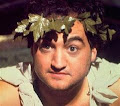Review: Sir Henry At Rawlinson End (1980)
>> Sunday, November 25, 2007

UK/B&W-73m./Dir: Steve Roberts/Wr: Vivian Stanshall & Steve Roberts/Cast: Trevor Howard (Sir Henry Rawlinson), Patrick Magee (Reverand Slodden), Denise Coffey (Mrs. E), J.G. Devlin (Old Scrotum), Harry Fowler (Buller Bullethead), Sheila Reid (Lady Florrie Rawlinson), Vivian Stanshall (Hubert Rawlinson/Narrator)
Ranging from merely eccentric to downright strange, Sir Henry At Rawlinson End defies description, but I will make an attempt just the same. Bombastic aristocrat and dedicated dipsomanic, Sir Henry Rawlinson (Trevor Howard) shares his manor with the ghost of his dead brother Humbert (Vivian Stanshall), who Henry killed in a drunken duck hunting accident. Humbert can not go to his eternal rest, because he isn’t wearing any trousers; so he spends his time walking a toy dog and diluting Henry’s brandy with dog urine. This becomes too much for Henry. Consequently, he sends for a corrupt priest (Patrick Magee) to exorcise the spirit before the Blazing, a festival which involves pulling an Excalibur-ish sword from the muck and hacking limbs off the local peasants. While this is going on, two German soldiers, which Henry has locked inside his personal POW camp, are planning an escape, and Henry’s housekeeper rambles incessantly about her husband’s tapeworm. If anything, that description makes the film sound a lot more coherent than it actually is.
Sir Henry sprung from the mind of Bonzo Dog Band’s bipolar madman, Vivian Stanshall, who initially spun stories of Rawlinson End in the form of radio broadscasts and record albums. Stanshall’s writing combined the madness of Spike Milligan, the impenetrable abstraction of Samuel Beckett, and the knotted wordplay of Lewis Carroll--which would make one think that the material would be unfilmable. Director Steve Roberts answered the challenged by creating an off-kilter, sepia toned word, which was the visual equivalent of Stanshall’s nonsense poetry. The A-list cast appear to be having the times of their lives, and although the story isn’t easy to follow and the editing is pretty haphazard, one can’t help but smile throughout the proceedings.
Of course, this bizarre cocktail is not for all tastes. Those looking for logic or coherence in the narrative are in for a hard slog. However, if you just let the film wash over you like a grand drunk, you will find humor and enjoyment aplenty.
Drinks Consumed--Brandy, ale, sherry, and wine
Intoxicating Effects--Belching, boasting, staggering, harmonizing, physical violence, and hangover
Potent Quotables--SIR HENRY: If I had all the money I’d spent on drink, I’d spend it on drink.
Video Availability--Unfortunately, Sir Henry is only available on DVD in Region 2 (Digital Classics). If you own an all-region player and are adventurous enough to view this oddity, I’d suggest watching it with the subtitle option on. Due to the thick accents, muddy original recording, and complexity of the prose, you’ll need the subtitles to catch many of the jokes.
Similarly Sauced Cinema--The inhabitants and guests of an English country house are rude, lewd, and stewed in Futtock's End,
Sir Henry at Rawlinson End (CD)
Sir Henry at Rawlinson End [ NON-USA FORMAT, PAL, Reg.2&4 Import - Australia ]








































